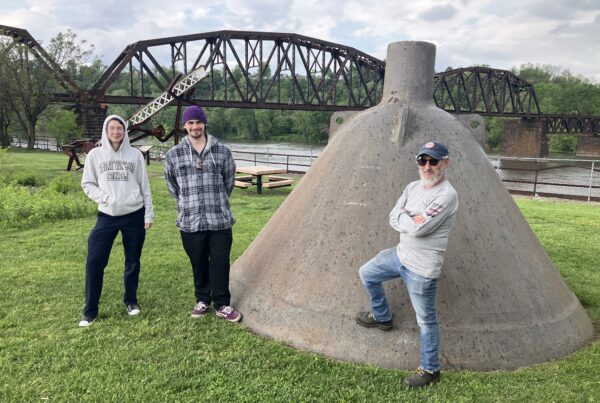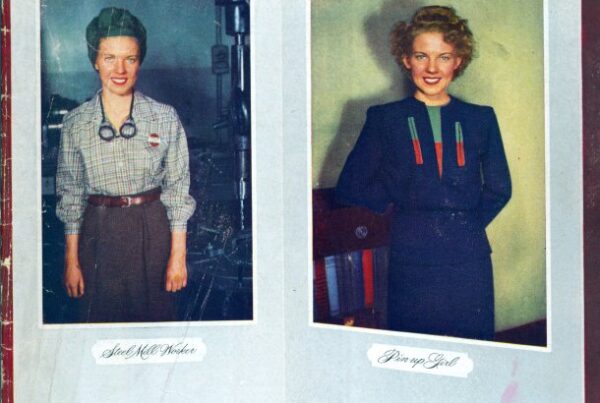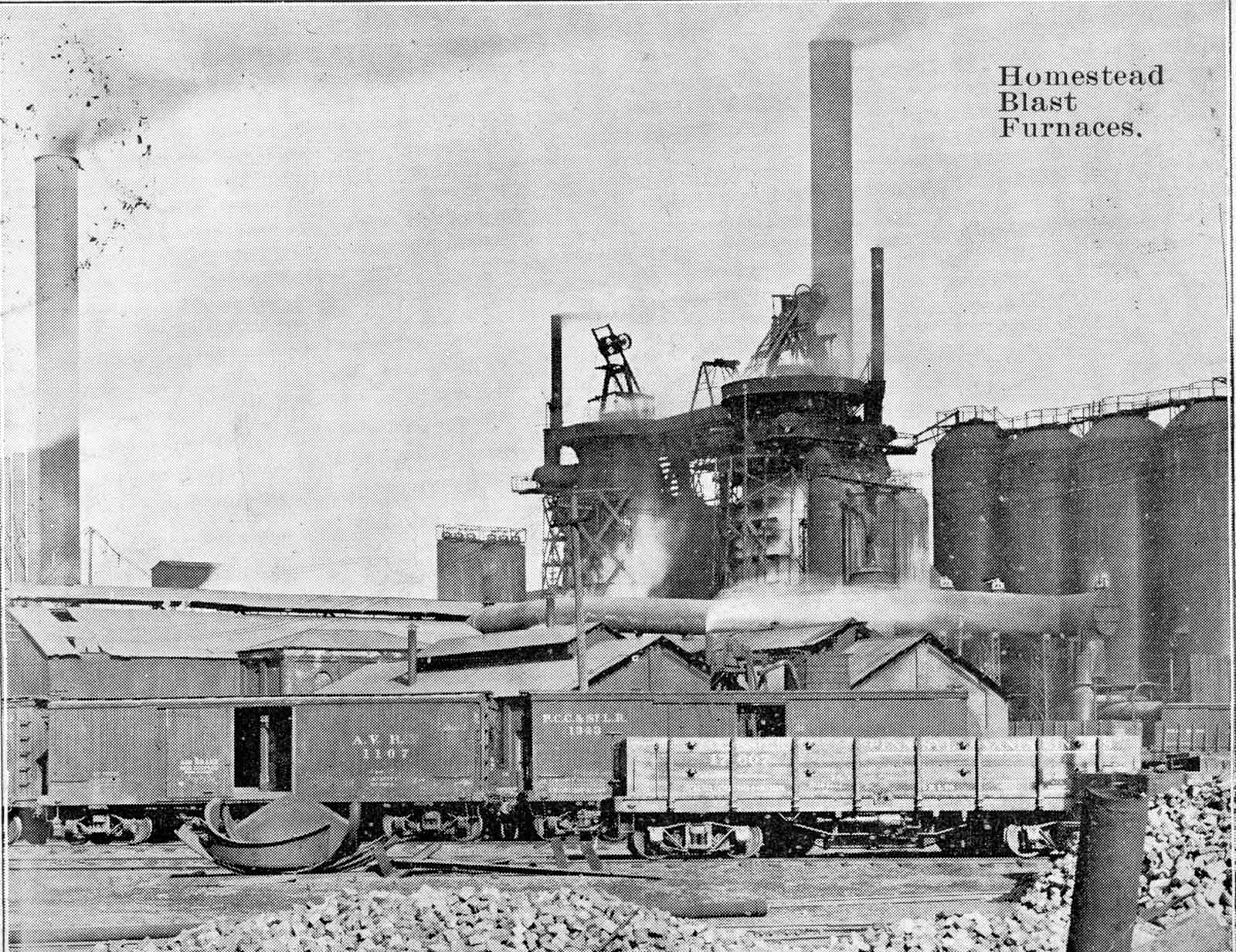
An early image of the Carrie Furnaces #1 and #2. Collection of the Rivers of Steel Archives. The Carrie Furnaces were named in honor of Carrie Clark.
She Who Lit the First Flame
After years of research, we finally know who is the namesake of the Carrie Blast Furnaces.
By Dr. Kirsten L. Paine
Who is Carrie?
“Who is Carrie?” Any tour guide at the Carrie Blast Furnaces will say that this is their most frequently asked question.
Legend had it that Carrie was Carrie Fownes, the daughter, sister, mother, or aunt of one of the Fownes brothers, who were two of the founding owners of the Rankin mill. The problem, however, is that there were very few substantive references to a Carrie—or the more formal Caroline—Fownes linking her to the mill itself. Family histories did not show a woman with that specific name.
A standard answer from tour guides alluded to the speculative Fownes family connection before providing the context behind the historical practice of naming blast furnaces after the wives, daughters, and sisters of the mill owners. Among nineteenth-century blast furnaces like Carrie, there were Dorothy, Eliza, Jane, Isabella, and Bernice, among others.
Furnaces bore women’s names as a means of acknowledging a female member of a prominent family. Simply put, nineteenth-century women were unlikely business owners. They rarely owned property, controlled bank accounts, or held positions of power and influence in public commercial circles. Women in wealthy families, like the Fownes family in Pittsburgh, exerted sociopolitical influence in domestic and home-adjacent spaces. Naming a furnace after a woman gave her both a presence and a stake in the family enterprise. It also created monuments to women’s memory by an industry not remembered for welcoming women’s presence, participation, or investment.
“Who is Carrie?” This is a tantalizing question for any historian. Ron Baraff, director of historic resources and facilities at Rivers of Steel, says, “I have been looking for ‘Carrie, the Person,’ since 1998. While there were many reference clues, they were always incomplete, a historical afterthought.”
Witnessing the magnitude of the two preserved furnaces on the Monongahela mill site makes it hard to think about Carrie as a “historical afterthought.” There she rests in her anthropomorphized glory—tended, cared for, visited, celebrated, and as full of life as she ever was. Her name runs to the heart of Pittsburgh’s living memory for those who worked at the mill when it was operational, lived in the neighboring communities of Swissvale and Rankin, and saw the glow, fire, and soot and heard the metallic rumble and roar. Baraff says, “I feel like I have been looking for Carrie my entire life!”
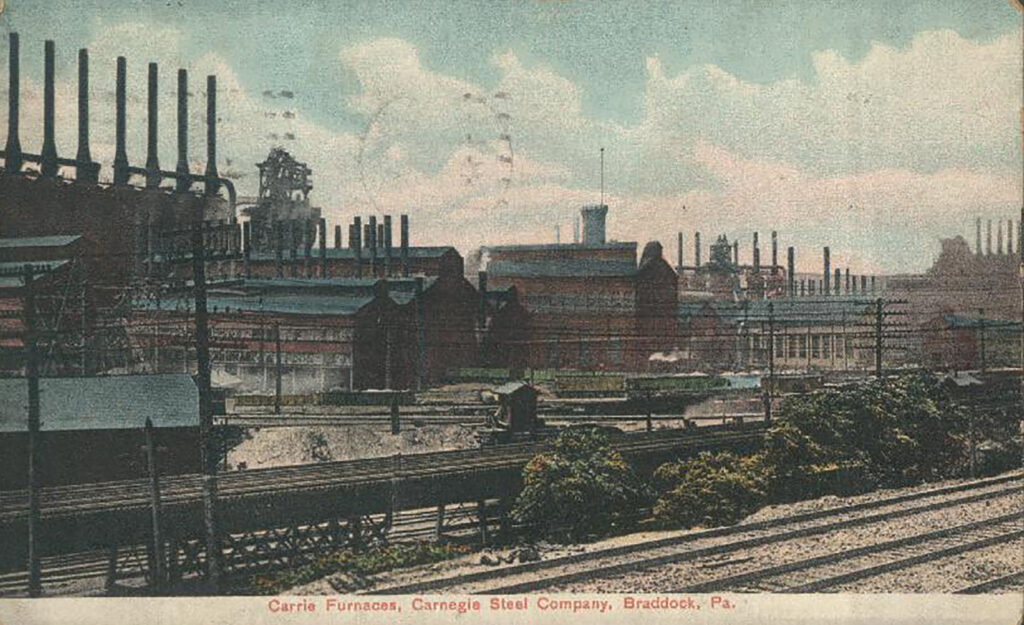
The Carrie Furnaces in the Carnegie Steel era, a rapid expansion from the first furnace fifteen years before. Collection of the Rivers of Steel Archives.
Carrie Is Revealed
The Carrie Furnace Company began in 1884. Brothers H. C. and W. C. Fownes were founding partners and hands-on managers of the company, which had other investors and interested parties. William Clark, the Fownes brothers’ maternal uncle, was a prominent figure in the Pittsburgh iron industry and known primarily for Solar Iron Works. He became the president and manager of his nephews’ new venture.
When Furnace No. 1 smelted its first tons of iron on February 28, 1884, the whole Monongahela River valley knew about it. All of Pittsburgh knew about it. In the latter decades of the nineteenth century, any time a new mill opened in the Monongahela River valley, area newspaper reporters converged on the site to write stories about opening ceremonies. These ceremonies were not unlike christening new ocean liners. The social, political, and economic elite congregated to celebrate the new venture, which contributed to expanding the global prominence of Pittsburgh’s industrial might.
The Pittsburgh Daily Post covered the excitement. On page four of the February 29, 1884, edition, the staff reporter filed an article called, “The New Rankin Station Furnace.” It reads, “the new furnace at Rankin Station on the Baltimore and Ohio railroad, about [ten] miles from the city was yesterday morning christened the ‘Carrie Furnace.’”
Ron Baraff found this article while scouring Pittsburgh newspapers for information on the early days of the Carrie Furnace Company. He continued reading the article and noticed the furnace was named “in honor of Miss Carrie Clarke [sic] who lit the fires and performed other baptismal services.” William Clark’s daughter (and the Fownes’ brothers’ first cousin) had been tucked away in a few lines of local journalism!
Those lines, however, provided “the proof that eluded us for so long,” said Baraff. Those lines “give us not just a name to affix to the narrative, but they opened the door to a life and time in our region’s rich industrial history.”
Ron’s discovery kicked open a door for the rest of Rivers of Steel’s Museum and Archives department, who quickly set to finding as much information as possible about Carrie Clark. They “went on a quest to find out more about our Carrie,” Baraff says. Over the next few days, emails zipped back and forth as Ron, Ryan Henderson, Barney Terrell, and I followed her across the historical record and recovered the identity, life, and legacy of the woman whose name echoes throughout the Monongahela River Valley.
Ron remarked the “longtime assumptions were close to being accurate,” but because of the focus on the Fownes family, the Clark family and their connections to each other went unexplored. Finally, being able to reclaim a person’s entire life story with the simplest premise: “Who was Carrie Clark and what happened to her,” well, “it is a researcher’s dream.”
Ron, Ryan, Barney, and I found census records, marriage license notices, academic files, obituaries, and cemetery records. Her present biography remains short, and at first glance, it may appear sparse. However, remember this biography represents a major breakthrough in a twenty-five-year-long quest.
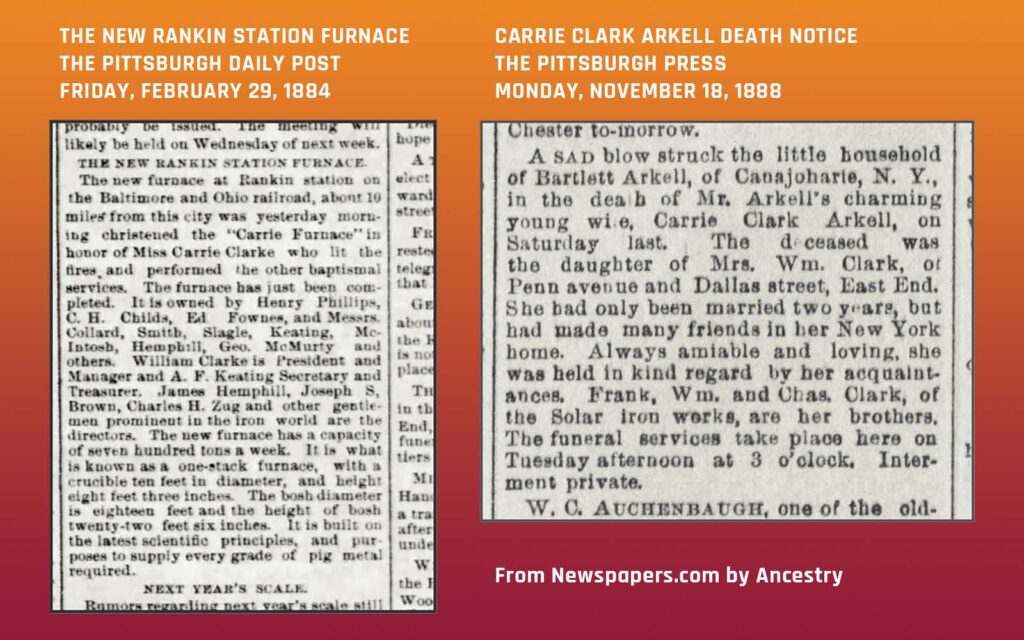
Carrie Clarke is mentioned as “she who lit the fires” in a notice about the christening of the new “Carrie Furnace” in 1884, and then news of her death is shared in 1888.
Carrie Clark, a Life
Caroline “Carrie” Bell Clark was born on March 19, 1863, in Youngstown, Ohio. Her family moved to Pittsburgh before 1869, when her father, William Clark, started the Solar Iron Works, located in Lawrenceville. In 1877, Mr. and Mrs. Clark sent Carrie away to Vassar Preparatory School in Poughkeepsie, New York. While there, she completed courses in Latin, German, French, Greek, mathematics, rhetoric, geography, and history. In 1880, Carrie Clark began studying at Vassar College, an institution that endeavored to provide wealthy young women educations equal to what their brothers received at other elite universities. Clark left Vassar and returned to Pittsburgh in 1881.
She assumed an extraordinarily public role in February of 1884 when she assisted her father by lighting that first fire in the brand-new mill bearing her name. A flurry of activity befitting a wealthy young woman in the late-nineteenth-century United States ensued. William Clark died in August 1884, a mere six months after the mill’s opening. Less than two years later, Carrie Clark married Bartlett Arkell, the rather dashing son of a New York State senator, in Pittsburgh, likely close to the Clark family home in Point Breeze on the corner of Penn and Dallas Avenues, on November 30, 1886. Clark and her new husband relocated to his hometown of Canajoharie, New York, shortly thereafter. Their son, William Clark Arkell, was born on September 28, 1887.
Carrie Clark died on November 17, 1888. She was twenty-five years old. Her obituary describes her as “charming” and “always amiable and loving” toward her friends. Her body was brought back to Pittsburgh. She rests in the Clark family mausoleum in Homewood Cemetery, Section 14, Lot 111.
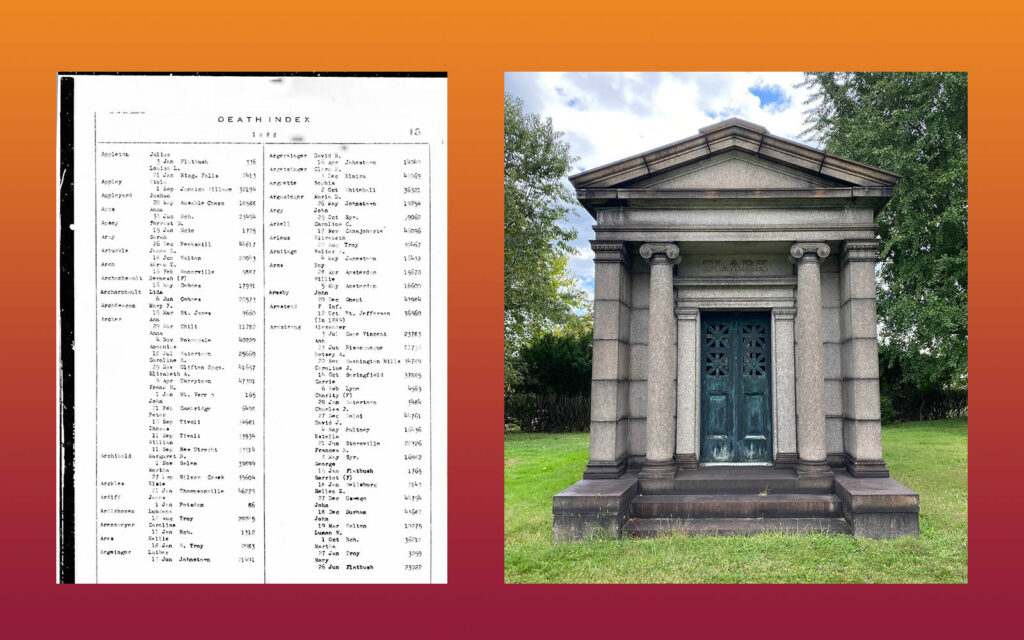
Carrie Clark Arkell’s is included in this 1888 Death Index. She is entombed in the Clark family mausoleum in Homewood Cemetery.
Carrie for the Ages
Restoring Carrie Clark’s identity to the record of Carrie Furnace reinforces the fact that the history of industry in Pittsburgh includes, and sometimes even centers, women. Women’s lives and contributions to the mills, regardless of whether or not their sacrifices lay at the base of a blast furnace, open hearth, rolling mill, or in a rail yard or a coal mine, matter.
Clark is a piece of Pittsburgh’s industrial story. When asked if he thought Clark’s identity would change the way people look at the furnaces and what he hopes the public will take away from knowing her name and at least a little bit about her life, Ron Baraff expounded, “We can provide a more complete narrative of the early days of the company and its founding families and of the industry and region.
“Carrie Clark is an important player in the life of the site—her name and her legacy (and that of her family) echoes from the nineteenth century into the twenty-first,” Ron continued. “No longer is she just a name. Now she is a person, a life, a connection to our collective past. History is at its best when it is viewed humanistically and with dimension, taken off the pages of books and brought to life. It becomes relatable and real. It is our job as historians and interpreters to serve as guides for others to understand the past and make it come alive again.”
This is a turning point for Rivers of Steel’s story as well. Not only does the organization steward the National Landmark bearing her name, but Rivers of Steel now stewards the memory of Carrie Clark, the young woman who lit the first flame.
 Dr. Kirsten L. Paine is an educator and researcher with more than a decade of experience working in higher education. She started working for Rivers of Steel in 2017 as a tour guide at the Carrie Blast Furnaces National Historic Landmark and was inspired by the mission to preserve such a national treasure held in public trust. Kirsten is committed to the work of public humanities education in her role as Site Management Coordinator and Interpretive Specialist. By creating and facilitating public programs that make the National Heritage Area’s history come alive for the community, she believes in archival study and teaching from primary sources as vital community resources.
Dr. Kirsten L. Paine is an educator and researcher with more than a decade of experience working in higher education. She started working for Rivers of Steel in 2017 as a tour guide at the Carrie Blast Furnaces National Historic Landmark and was inspired by the mission to preserve such a national treasure held in public trust. Kirsten is committed to the work of public humanities education in her role as Site Management Coordinator and Interpretive Specialist. By creating and facilitating public programs that make the National Heritage Area’s history come alive for the community, she believes in archival study and teaching from primary sources as vital community resources.
Enjoy Dr. Kirsten L. Paine’s article? Read part two in the series about Carrie Clark.

